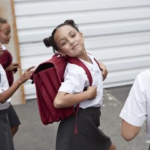
18 Jan 7 Ways to Support the Transition to Secondary School
It’s a mix of emotions – like excitement, nervousness, or uncertainty – in the lead-up to big changes, writes Shelley Lipshut
The leap from primary to secondary school marks a profound milestone in a child’s educational journey. It is a juncture teaming with anticipation and trepidation. While gently guiding your child through this transition is crucial, it also presents an opportunity to empower them to explore their independence, stretch their potential and cultivate resilience.
For parents embarking on the secondary school journey with their children, there are seven invaluable ways to support them through this pivotal time. Fostering stability, engaging in candid conversations, building relationships, and affording opportunities for teens to embrace trials, triumphs, and growth will be key.
Open communication
Start by having open conversations with your child about their expectations, fears, and hopes regarding their transition into secondary school. Discuss concerns they may have and assure them that it’s natural to feel a mix of emotions – like excitement, nervousness, or uncertainty – in the lead-up to big changes.
Encourage them to fully engage with their new experiences, even when these experiences are uncomfortable or difficult. Let them know they have a safe support system at home and at school, but they are also resilient and strong enough to navigate any challenge. This is a wonderful opportunity for students to build and maintain resilience, a key skill that will support them through their secondary school journey and help them bounce back from hardship or failure.
Build relationships with their new school community
Consider engaging with their new school community early. Attend school tours, information sessions, transition days or other on-campus events like performances, concerts or fundraisers. If you share connections with families also enrolled at the school, arrange an informal get-together to acquaint your child with future classmates.
Starting secondary school often means making new friends, so encourage your child to be open to forming new relationships – even if they already have an established social group. Social challenges during this time are commonplace, so remind your child it’s likely other students are feeling the same way.
Before the school year commences, explore the diverse array of co-curricular activities that are available to your child. Encourage them to join clubs and sports teams or pursue hobbies they’re passionate about. These activities not only foster personal growth but also facilitate relationships across various social circles.
 Support independence
Support independence
Secondary school creates the opportunity to test and build independence. Empower your child to shoulder responsibility for organising their learning materials, packing their lunch, and managing their time to ensure they arrive at school or at home when expected. These practices nurture self-reliance and increased autonomy.
For students commuting independently, ensure they are comfortable with the travel route and timetable. Consider doing a practice run together to bolster their confidence before their first day. Discuss a contingency place if public transport is disrupted or safety concerns arise.
Organisation and study skills
The start of secondary school ushers in increased academic demands. Help your child develop effective organisation and study skills by introducing planners or digital calendars. These can help with managing homework assignments and extracurricular commitments and with staying on top of deadlines.
Learning how to manage time, commitments and deadlines is a core part of secondary school. Establish a dedicated study space at home, set a regular study schedule, and aid in breaking down assignments into manageable tasks. Regular check-ins with your child to ensure assignments are progressing will reduce last-minute stress and late study sessions.
Stress Management
Secondary school’s academic demands and social complexities can be uncomfortable and stressful. As a parent, there is often the temptation to resolve these concerns on behalf of your child. Instead, normalise these feelings and let your child know it’s ok for things to be difficult. Instead of trying to fix the problem, focus on practical strategies that will help your child manage what is causing them stress or bad feelings.
Deep breathing exercises can be a quick and effective way to regain focus. Introduce mindfulness practices that promote staying in the present moment and foster resilience. Encourage them to engage in physical activities they enjoy, whether it’s sports, dancing, or simply taking a walk, to boost overall well-being. Encourage them to spend time with people who make them feel good.
Emphasising the importance of perseverance and building a growth mindset will enable them to bounce back from setbacks and adversity in the future.
Safe smartphone usage
With increased access to technology, prioritising your child’s online safety is paramount.
Students entering secondary school will likely be using smartphones and social media independently for the first time. Beyond setting usage guidelines and expectations, have candid conversations about responsible online conduct.
Emphasise the importance of safeguarding personal information and the dangers of sharing personal details online. Explain the benefits of using privacy settings on social media platforms, how to identify signs of cyberbullying and the steps to take if they encounter it, such as blocking the aggressor and reporting the incident to a trusted adult or school authority.
Uniform, supplies and self-expression
Ensure your child has the necessary stationery, notebooks, textbooks and organisational tools well in advance of the first day of school. The booklist provided by the school should outline the required learning materials for each subject. For schools embracing digital devices, consider the necessity of a laptop or tablet.
Review the school’s uniform policy, including dress code requirements. This will help them start the school year with confidence, knowing they are adhering to the rules. Try on the school uniform to ensure that no alterations or different sizes are required prior to the first day of school.
Encourage self-expression within the guidelines set by the school, allowing your child to personalise appropriate items such as a backpack or stationery. This enables them to express their individuality while maintaining uniformity within the school’s regulations.
The transition to secondary school is a journey that unfolds over time. Encourage your child to be open to new experiences, to be patient when things are hard, to celebrate their achievements, and to grow from their mistakes.
As they embark on this new chapter, recognise that the adventures and challenges ahead will serve as a strong foundation for their academic, social, and personal development. With your unwavering support, they will navigate secondary school and thrive within it, setting the stage for a bright and promising future.
By Shelley Lipshut, Year 7 Coordinator, Strathcona Girls Grammar




